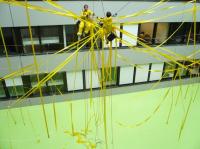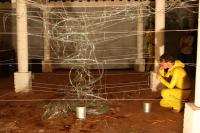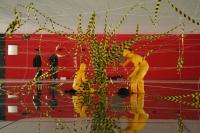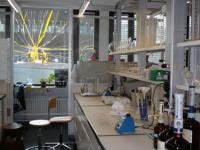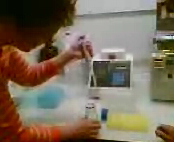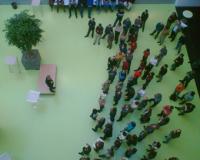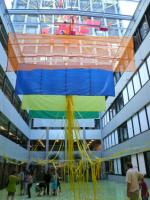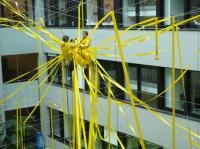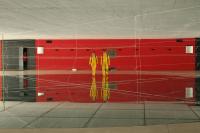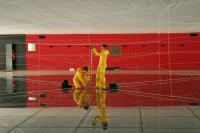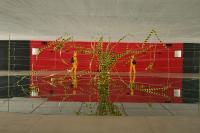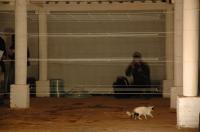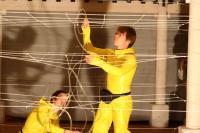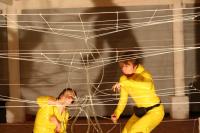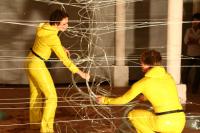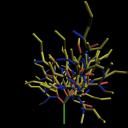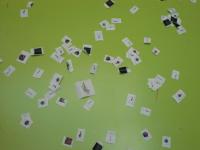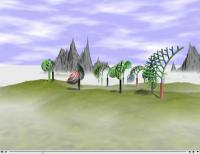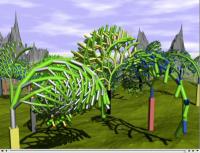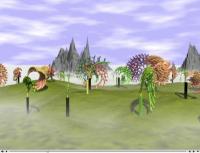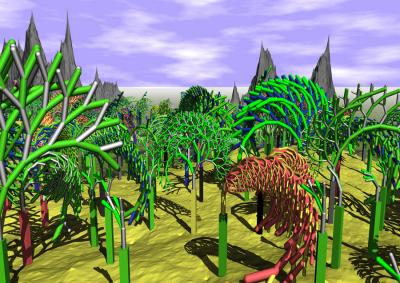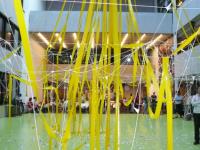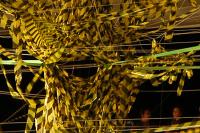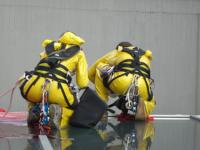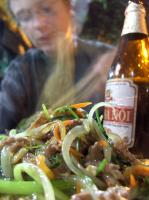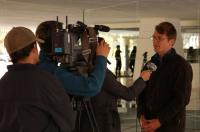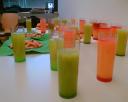Artists-in-Labs (results and conclusions)!
January 9th, 2008 by edenSee climbing performance-movie “Cell” and “VietNamEden”
Regrowing Eden (final report)
The international art & science project Artists in Labs with performance-installations in Switzerland, Vietnam, Brasil and our Virtual Eden is over – but Regrowing Eden will continue to grow! Please read our final report with the main results and conclusions…
Exract from our final Artists in Labs-report:
Artists-out-of-lab (May/June)
Not earlier than during our artists in labs-application interview we were overwhelmed by a sudden feel that we need to broaden up our scope and to get out of the lab: while scientists are still studying the risks and chances of genetic engineering (GE) in the lab, the genetically modified organisms (GMO) are already out there in the real world, around the globe. With an investigation on the ground, we wanted to explore how scientists and policymakers communicate the risks of GE/GMO and how the public perceive these. We decided to go to Switzerland, Brazil and Vietnam in order to carry out field researches and to instantly make installations and performances. The three countries are chosen because of their relevance in GE and because we could build on the GE/GMO risk assessment programmes that our scientific partner, Dr. Angelika Hilbeck from the ETH Institute of Geobotanics, was carrying out in those countries.
But before leaving the lab we went into it and learned some of the GE-basics: we extracted DNA and analysed their activity with a photo spectrometer, we learned how to design a proper risk assessment and apply methodologies, for example how to measure unwanted side effects, f.ex. negative effects of GMO on non-target organisms or on the soil. In order to capture the opinion of scientists and to get an impression of the social discourses on GE/GMO we developed a standardised questionnaire and made interviews with scientists, policymakers, artists and any other stakeholder that we could grab.
As the issue of GE/GMO is pretty complex and difficult to understand, the performances about it rather short and easy to be missed, and as we wanted to involve as many people as possible, we put a lot of emphasis on the communication of our project. Therefore, with www.regrowingeden.ch, we created an easy accessible communication platform with a blog, project-specifications, photo-documentation, online-questionnaire and feedback-tools. Step by step we translated all content into German, English, Portuguese and Vietnamese.
Our working concept over the nine months was as simple as effective: go there and adapt to the local situation, talk to the relevant scientists, policy makers and normal people in order to get an impression of the GE/GMO situation in the specific country, speak to artists and curators with the aim to find a suitable location for our performative installations, invite everybody to our vernissages, finissages and in-between-performances, and give room for feedbacks and interdisciplinary discussions through self-organised art-cafés, finissage-party or art-science-dinner…
regrowingeden.CH (June/July)
When we saw the bright-green painted floor of the main hall of the institute of integrative biology we just knew that this would be the place for our first installation. The building was topped with a roof of glass where the light could enter and behind you could see the facade of the tower of the Environmental and climatological department of ETH Zürich. We felt that this building is like a huge brainfactory, where the scientists are studying in their small rooms. We felt that these were like cells forming a bigger entity, a living organism. After a short non-bureaucratic procedure we got the permission to make a 1-month installation in the building. Since we wanted to use the full space within this giant cell structure, we started to climb along the walls, putting up a net structure as a basic matrix for our artificial plant to grow. We were struggling with fire alarms and other technical problems, but were experimenting night after night of what we could do in this room. In the end we developed a performative installation – an installation that was built and changed through 5 performances, including 2 climbing performances and 1 on the fragile glass roof. In short, we simulated the whole lifecycle of a GMO-plant and tried to give reflections on how a GMO-plant feels when bombarded with foreign DNA in order to form a new superspecies, a hybrid with functions from more than one species. In the end, our GMO-plant was growing out of the artistic white cube/the scientific lab and grew invasivly along the 30m tall façade of the ETH-tower. In order to enhance the dialogue between artists and scientists, we were organising art-cafés during the scientists café-breaks or after the performances. We sometimes were impressed by the fact, that most of the scientists were not to distract from their concentration – even when we were passing by their offices from the other side of their windows during our climbing performances!
Transgênicos (August/September)
Shortly after, we boarded the airplane for Brazil, a leading exporter of GMO-cotton and famous for its rainforest-destruction partly because the substitution with GMO. We had a few contacts and nothing more than one month to organise and realise our Eden no Brazil. According to Greenpeace Brazil, the GMO-debate seemed to be the hottest in Paranà -state where a legal battle between the state and federal government is going one for years already. So we went to Curitiba and tried to link up with the responsible state officials. They endorsed our project and after one week of negotiations they made us perform in the prestigious Curitiba Museu of Oscar Niemeyer, famous for his unique architecture – opening in three days! So we were busy looking for suitable materials and preparing our installation. By the end of the month, we built an installation that was developed through 3 performances. Starting from an empty string-structure, we used signal tape to draw a light 3-dimensional sketch that was consolidated to a dense plant-sculpture during the next performances. We, too, had a special performance for 200 state officials that were taking part in a governors briefing. The Governor apparently liked our artwork and invited us for lunch to his office up in the top floor of the Government building. We always were conscious in keeping the fragile balance of not being instrumentalised as “artists against GMO”, therefore we insisted in writing the press statement ourselves and spoke directly to the press. Beside that, we met local artists and had a nice party after our closing performance with in depth-discussions about what is art and what is performance – for the curators of the Museu Oscar Niemeyer, performance was a new concept and not so easy to explain…
Viet Nam Eden (October/November)
When we landed in Hanoi – the city of the soaring dragon – we thought, that this country would be our biggest challenge. The Socialist Republic of Vietnam is characterised by a system of political control and an ultraliberal economy. Vietnam is the world biggest rice exporter, the development of GE/GMO is a national top priority (despite the fact that there is no legal framework for GE/GMO in place yet). So, we didn’t know whether we would be seen as something that the art censurer has to deal with or whether we would be used as “GE/GMO-promoters” for the starting pro-GE/GMO propaganda. In fact, the first talks with better established art-places did slow down our enthusiasm a little bit – but encouraged us to contact a full range of young artists and curators of a very dynamic and creative subcultural art scene. And we were surprised about their openness and interest in the intercultural exchange! Also the scientists and policymakers that we contacted did welcome us warmly. In fact, we too loved “riding the dragon” as Vietnamese people say: we adapted to the local circumstances as best as we could, used chopsticks and ate at the small chaired food stalls in the street, tried to repeat complicated words in Vietnamese language, curved around the incredibly busy streets of Hanoi with our own rented Honda wave-motorbike, made our first business cards in order to better take part in the presentation rituals and went karaoke singing with our new artist friends. So, within two weeks full of meetings, presentations and discussions, we had an overview of the GE/GMO-situation in Vietnam and even have found a perfect location for our installation. The Nha San artspace was just great – Duc and his crew did take some risks with hosting us in his unofficial but important experimental artspace. It is a very old, traditional stilt house like the ethnic people from the northern mountains used it for centuries. The architecture and the atmosphere did contrast very nicely with the gene-technology content and our artistic approach. In two performances over a period of ten days, we created an artificial plant of plastic tubes within a matrix made of strings. We sucked yellow and red colour through the transparent tubes and let the GMO-plant grow into the courtyard. GE/GMO is almost unknown in the public – therefore we used another terminology and invited everybody for an art-science discussion dinner, where we cooked a Swiss-Vietnamese meal. Through the food, we were able to explain and discuss the topic on a concrete everyday basis. People liked how we crossed the line between artificial and natural and combined installation and performances, science and art, Switzerland – Brazil – Vietnam.
virtual eden (ongoing!)
We were obsessed by the idea to make a simulation of a virtual “genetically modified organism” – a plant whose growth depends on the public opinion in different countries. As we didn’t have a clue how to make this, we asked more experienced peoples for their help. Now, www.regrowingeden.ch is also the place for our virtual garden Eden. It is still under completion – so fill in the online-questionnaire and instantly get “your opinion on GE/GMO as an artistic picture”. Your answers from the questionnaire are transformed into an artistic picture or “virtual plant”. In the end, we will create a virtual Garden Eden-scene with an animated plantgrowth of individual plants – the Regrowing Eden-movie on the social discourse on gene-technology! The fractal-images are calculated with the great contribution of Hansrudi Noser from the Zurich Institute of Informatics. They are an interpretation from the Lindenmayer-system – the programming has parallels to the universal genetical code.
Mission completed – lessons learned
The official AIL-project is over and we look back to nine very interesting and intensive months. We learned a lot about science in the different the socio-political contexts. We understood, that even scientists are humans! In the end, the scientific results are rather subjective findings depending on the deeper-rooted ideology and motivation of each scientist. Through our work, we made so many contacts and even met new friends. Generally we stated that the public is rather critical regarding the possible GMO-risks. But the level of understanding and involvement differ very much between the three countries.
Our project plan was to elaborate three different performative installations, that reflect the specific situations and to allow an artistic and scientific comparison between the three countries. Looking at the results, we think that we fullfilld our mission – in the real world as well as in the cyber space.
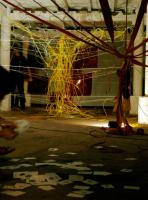
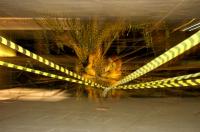
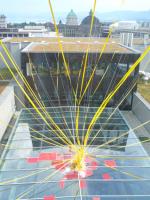
We want to highlight, that in the end each location, where we could make our art-installation, was somehow characteristic for the GE/GMO-situation in the specific country: the green-floored research building of Swiss ETHZ allowed a maximum of differentiation and freedom of experimentation – Switzerland is known for his differentiated public discourse on GE/GMO: while not accepted in food and on the fields, the Swiss people enhance scientific research on GE/GMO; the red-walled, famous Museum Oscar Niemeyer in Brazil was politically hot – we were allowed to make performances on GMO, resp. GMO-risks in that prestigious building as the museum directress’ husband was the governor of Paranà state himself, known for his anti-GMO-policy and fierce fight against the pro-GMO-dictate of the Brazilian federal government; the brown-floored Nha San artspace in Vietnam represented the unofficial existence of GE/GMO – as from the Socialist Republic of Vietnam officially not recognised as an important avant-garde artspace (resp. considered as illegal), GE/GMO officially does not exist either (there is no legal GE/GMO framework in place and therefore it is illegal); but as important Nha San is for the artscene in Vietnam, as real genetically modified plants are already growing on the fields – unofficially!
The collaboration among us – Hina & Mätti – was great. Together we managed to work with the needed openness and straightness even under difficult and adventurous circumstances.
Conclusions and recommendations
With gene-technology, humankind designs new life. It was great having had the opportunity to examine the complexity of genetic engineering and to reflect on the manner in which society interacts with nature. We appreciated having had the unique possibility for freely experimenting inside and outside of the lab in our two-persons-team. It would have been nice having had more time for an exchange with the other AIL-artists – but considering our dense schedule it was not very realistic. For us it was worthwhile to develop a certain self-initiative. We recommend the follow AIL-artists to do the same in order to get what they need…
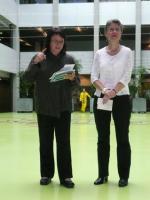
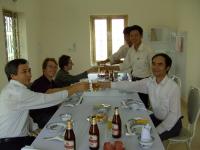
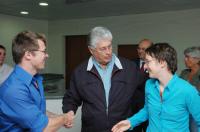
Credits (full list click here)
Dr. Angelica Hilbeck; Antonio Pietrobelli; Christof Sautter; Duc Nguyen Manh; Evelyne Underwood; Felix Marthaler; Georg Bauer; Hansrudi Noser; Huynh Thi Thu Huong; Dr. Nguyen Hong Son; Prof. Nguyen Van Tuat; Le Hien Luong; Margit Leisner; Octavio Camargo; Tran Luong; ETH Zürich; the entire Nha San Hanoi-crew; the Curitiba Museu Oscar Niemeyer-staff; Parana State Authorities from Sanepar, Claspar, APPA; Vietnamese state officials and scientists from MARD, FCRI, PPRI, VEPA, Hanoi University of Agriculture
Posted in Artists-In-Lab |  Comments Off on Artists-in-Labs (results and conclusions)!
Comments Off on Artists-in-Labs (results and conclusions)!
